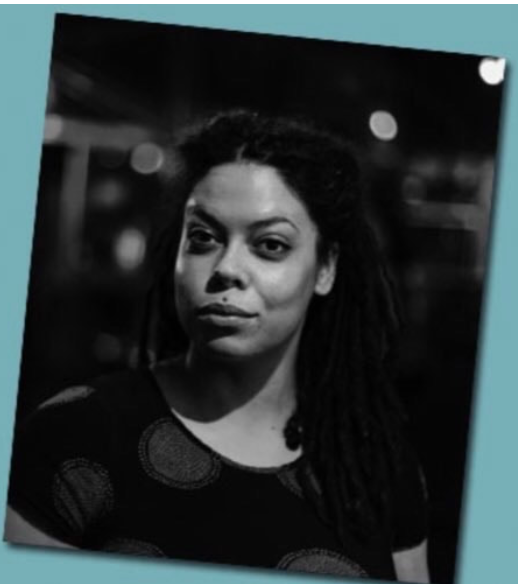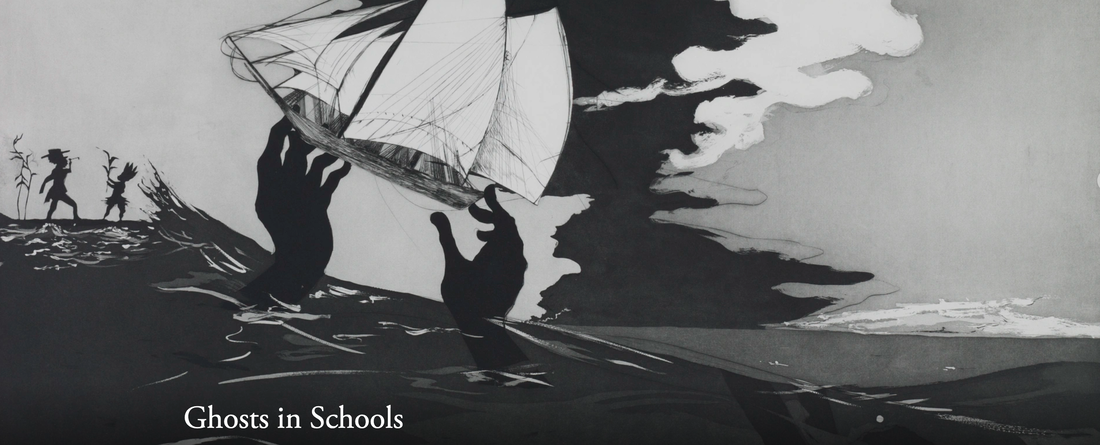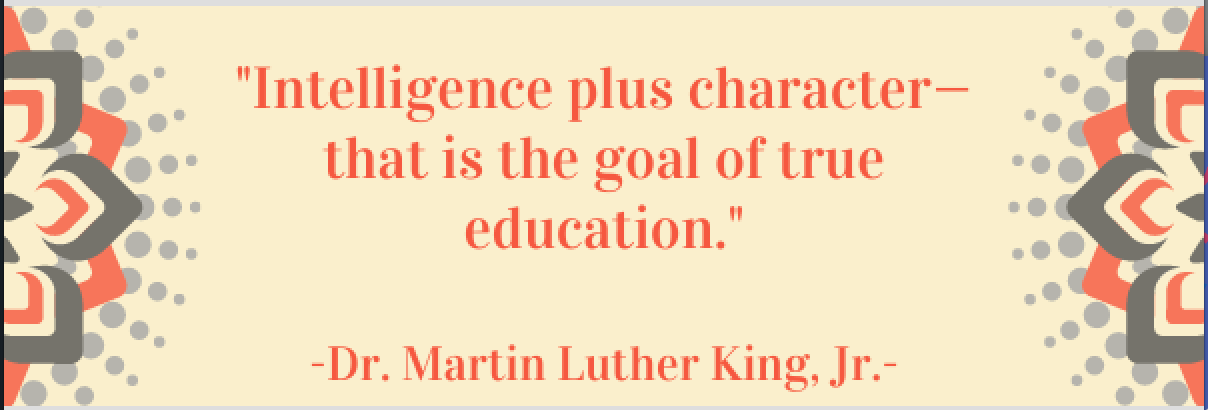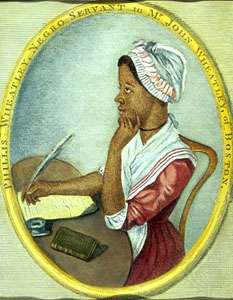For Inspiration: What do we do with a variation?
a poem by James Berry
Note: "Variation" can mean a change or difference or a different or distinct form or version of something.
|
What do we do with a difference?
Do we stand and discuss its oddity or do we ignore it? Do we shut our eyes to it or poke it with a stick? Do we clobber it to death? Do we move it around in rage and enlist the rage of others? Do we will it to go away? Do we look at it in awe or purely in wonderment? Do we work for it to disappear? Do we pass it stealthily or change route away from it? Do we will it to become like ourselves? What do we do with a difference? Do we communicate to it, let application acknowledge it for barriers to fall down? |
Part 1: Building Background - Talking About Race & Racism in America
First things first...what is racism? Let's agree on a common definition here and now. Discuss...
The three videos that follow will help us frame our classroom conversations about race. Each speaker talks about their experiences as Black Americans. Listen carefully to each man, Eric Deggans, Ta-Nehisi Coates and James A. White, as they talk about the world from their perspective.
After listening, we will break into small groups to discuss our answers to the accompanying questions. You will be provided with a handout on which to record your responses.
Talking about race can be uncomfortable, so before we actually begin, let's agree how these conversations will look, sound, and feel using "The Four Agreements of Courageous Conversations" written by Glenn E. Singleton (1992).
The three videos that follow will help us frame our classroom conversations about race. Each speaker talks about their experiences as Black Americans. Listen carefully to each man, Eric Deggans, Ta-Nehisi Coates and James A. White, as they talk about the world from their perspective.
After listening, we will break into small groups to discuss our answers to the accompanying questions. You will be provided with a handout on which to record your responses.
Talking about race can be uncomfortable, so before we actually begin, let's agree how these conversations will look, sound, and feel using "The Four Agreements of Courageous Conversations" written by Glenn E. Singleton (1992).
- 1. Stay engaged: Staying engaged means “remaining morally, emotionally, intellectually, and socially involved in the dialogue”
- 2. Experience discomfort: This norm acknowledges that discomfort is inevitable, especially, in dialogue about race, and that participants make a commitment to bring issues into the open. It is not talking about these issues that create divisiveness. The divisiveness already exists in the society and in our schools. It is through dialogue, even when uncomfortable, the healing and change begin.
- 3. Speak your truth: This means being open about thoughts and feelings and not just saying what you think others want to hear.
- 4. Expect and accept non-closure: This agreement asks participants to “hang out in uncertainty” and not rush to quick solutions, especially in relation to racial understanding, which requires ongoing dialogue.
Video 1: How to Talk About Race by Eric Deggans (9:46)
|
|
After viewing the film, discuss the answers to the following questions with your teammates.
|
Video 2: When Every Word Doesn't Belong to Everyone by Ta-Nehisi Coates (4:59)
|
|
After viewing the film, discuss the answers to the following questions with your teammates.
|
Video 3: The Little Problem I Had Renting a House by James A. White (13:44)
|
|
After viewing the film, discuss the answers to the following questions with your teammates.
|
Part 2: Building Background Knowledge - What is Race? Anticipation Guide
We are going to examine our own understanding about race. According to Webster's Dictionary, race is "a category of humankind that shares certain distinctive physical traits." Is this an accurate definition? Perhaps it was before scientists mapped the human genome. A genome is the complete set of genes present in each of our cells. It is those genes that determine the traits we inherit from our parents.
Just how different are we as human beings? Reflect on your own understanding of race by completing the What is race? Anticipation Guide linked below.
❓ What is race? Anticipation Guide
After completing your Anticipation Guide, explore the resources below to find out if your responses were correct. Each resource is numbered. After examining each resource, return to your Anticipation Guide and add to it what you've learned.
Just how different are we as human beings? Reflect on your own understanding of race by completing the What is race? Anticipation Guide linked below.
❓ What is race? Anticipation Guide
After completing your Anticipation Guide, explore the resources below to find out if your responses were correct. Each resource is numbered. After examining each resource, return to your Anticipation Guide and add to it what you've learned.
1# Watch the clip from the PBS film "Power of Illusion" posted below.
2# Read the article "The Race Theory" liked below. What did you learn?
3# Read the article "Ten Things Everyone Should Know About Race." What did you learn?
4# Read the article "“What Is Your Race?" by Courtland Milloy. What did you learn?
5# Watch Franchesca Ramsey explain the origin of the word "Caucasian" in her MTV video about the word. What did you learn?
Part 3: Understanding the Historical Context
of the "Weeping Time"
Activity #1:
Meet DAY OF TEARS author, Julius Lester. Mr. Lester was an award winning author of 40 books, 31 of which were written for young people. He was a college professor at the University of Massachusetts for 32 years. He has authored more than 200 essays, articles, and book and movie reviews. In addition, he was a well-known and well-regarded folk musician, a talented photographer, and a active member of the 1960s civil rights movement. Mr. Lester died at the age of 78 in January of 2018.
Directions: Watch each of the videos posted below and tell us what you think about the words and ideas Julius Lester shares in each. Share your thoughts on the first Jamboard posted in Google Classroom.
Meet DAY OF TEARS author, Julius Lester. Mr. Lester was an award winning author of 40 books, 31 of which were written for young people. He was a college professor at the University of Massachusetts for 32 years. He has authored more than 200 essays, articles, and book and movie reviews. In addition, he was a well-known and well-regarded folk musician, a talented photographer, and a active member of the 1960s civil rights movement. Mr. Lester died at the age of 78 in January of 2018.
Directions: Watch each of the videos posted below and tell us what you think about the words and ideas Julius Lester shares in each. Share your thoughts on the first Jamboard posted in Google Classroom.
|
Video 1:
Julius Lester, the singer and songwriter, discussing his role in the civil rights movement of the 1960s |
Video 2:
Julius Lester, college professor at the University of Massachusetts, discussing the idea of race. *NOTE: Begin the clip we want you to watch at 8:37 in and end at 13:10. |
|
|
|
Directions: Now, on the Jamboard posted in Google Classroom, respond thoughtfully to two of the quotes on the Jamboard slides.
| julius_lester_jamboard.pdf | |
| File Size: | 226 kb |
| File Type: | |
Click to set custom HTML
Activity #2:
Participate in a virtual gallery walk using Jamboard. This is how it will work. Examine each image on the Jamboard posted in Google Classroom.
Each image is a photographs of a sketch that has been preserved as an artifact of a different time in American history. These sketches originally appeared in newspapers from pre-Civil War America.
Directions: After examining and thinking about what you see on the Jamboard slides, respond thoughtfully. Your response may be a single word, set of words, sentences or set of sentences. It goes without saying, your responses must be school-appropriate and respectful of our content and classmates.
Participate in a virtual gallery walk using Jamboard. This is how it will work. Examine each image on the Jamboard posted in Google Classroom.
Each image is a photographs of a sketch that has been preserved as an artifact of a different time in American history. These sketches originally appeared in newspapers from pre-Civil War America.
Directions: After examining and thinking about what you see on the Jamboard slides, respond thoughtfully. Your response may be a single word, set of words, sentences or set of sentences. It goes without saying, your responses must be school-appropriate and respectful of our content and classmates.
| weeping_time_virtual_gallery_walk.pdf | |
| File Size: | 10586 kb |
| File Type: | |
Activity #3:
You will read closely two articles that will help you learn more about two of the historical figures introduced in the novel Day of Tears, Pierce Butler and his wife, Fanny Kemble. You will also read to learn more about the event that became known as the "weeping time" or the largest slave auction in American history.
Directions: As you read, answer the questions on the handout called "Weeping Time Research" Google Form. You may work alone or in pairs. Also, be aware that Google Form DOES NOT always save, so type your responses in a Google Doc first. When you've answered all the questions, copy and paste your answers from your Google Doc to the Google Form posted on Google Classroom.
For access to the articles, click on the following links:
You will read closely two articles that will help you learn more about two of the historical figures introduced in the novel Day of Tears, Pierce Butler and his wife, Fanny Kemble. You will also read to learn more about the event that became known as the "weeping time" or the largest slave auction in American history.
Directions: As you read, answer the questions on the handout called "Weeping Time Research" Google Form. You may work alone or in pairs. Also, be aware that Google Form DOES NOT always save, so type your responses in a Google Doc first. When you've answered all the questions, copy and paste your answers from your Google Doc to the Google Form posted on Google Classroom.
For access to the articles, click on the following links:
- Article 1: Judgment Day -- Fanny Kemble and Pierce Butler (PBS)
- Article 2: The Weeping Time (The Atlantic)
Figure 1: The "Weeping Time" Research Google Form you will use looks like the image below. Look for a link to this form in your Google Classroom.
Part 4: Reading Julius Lester's Day of Tears
Authors think long and hard about how they want to structure or organize their writing. In structuring their novels authors consider their audience, purpose, along with the content itself. Julius Lester chose to tell his story using four main structures including organizing chapters by setting and chronologically. He also uses a combination of dialogue that is structured like the script of a play, internal monologues, and interludes that take readers out of the time the novel is set in and into the future.
Read through the slide show below to learn more.
Read through the slide show below to learn more.
Reader Response Questions (BY CHAPTER CHUNKS)
Each week, for the next five, you will be reading an assigned number of chapters and responding to the questions in the slideshows below. We will have time to read the novel in class, and answer at least some of the questions. It is possible you may have to complete part of the weekly reader response questions at home, especially if you are absent or lose focus in class. Also, be prepared to discuss your responses to these questions at the beginning of the following week.
NOTE: The slideshows embedded below will be shared with you in Google Classroom.
NOTE: The slideshows embedded below will be shared with you in Google Classroom.
Learning Tasks Related to Day of Tears
During and after our reading of DAY OF TEARS, you will be asked to complete the following performance tasks presented below. These performance tasks will assess your learning of literary text-related concepts. The links below allow you to view the task. You will find your own copy of each tasks below in your ELA Google Classroom.
Task 1: Identifying MOOD (Chapter 1)
Task 2: Identifying and Explaining IRONY (Chapters 3 & 4)
Task 3: Drawing and Writing About Conclusions (Chapters 5 - 9)
Task 4: Recognizing the Power of DIALOGUE (Chapters 10 & 11)
Task 5: The Importance of Setting in Storytelling (After chapter 13)
Task 6: Comparing Two Texts on the Story of Jeffrey and Dorcas
Task 7: Writing A Comparison of Two Characters from Day of Tears
Task 1: Identifying MOOD (Chapter 1)
- Click on the link below to access the learning task related to mood.
Task 2: Identifying and Explaining IRONY (Chapters 3 & 4)
- Click on the link below to access the learning task related to irony.
Task 3: Drawing and Writing About Conclusions (Chapters 5 - 9)
- For this task we will first read an article about a third grade teacher named Jane Elliott's and the lesson she taught her students about race that has come to be called the "Blue-eyed, Brown-eyed Exercise." The article is linked here, but you will get a copy in class.
- CommonLit Link: https://www.commonlit.org/en/texts/the-blue-eyed-brown-eyed-exercise
- After our reading we will watch a portion of a video in which we will watch this exercise being performed. Here is a link to the video we will watch. Note that we will watch the video up until the 17:17 mark.
- Youtube Link: https://youtu.be/1mcCLm_LwpE
- Then with this in mind, we will return to our "What is Race? Anticipation Guide" and draw conclusions about the way Americans have traditionally thought about race and how those ideas, which are based on prejudice and not science, have led to a "racialized" society in which people have varying amounts of privilege based on their race. Note: If you need to check out my key for this, the link is here:
- Finally, we will write about both, what we learned about the consequences of grouping people by "race" (skin color). Below is the link to the writing task.
Task 4: Recognizing the Power of DIALOGUE (Chapters 10 & 11)
- You will receive this in the form of a handout, though you may also access this assessment here should you need it for some reason: The Function of Dialogue in Fiction
Task 5: The Importance of Setting in Storytelling (After chapter 13)
- Click on the linked document to complete the lesson.
Task 6: Comparing Two Texts on the Story of Jeffrey and Dorcas
- You will receive a handout of a portion of text from journalist Mortimer Thomson's story of Jeffrey and Dorcas, two of Pierce Butler's slaves
- Link to ReadWorks text below (Note: There are two serious errors in this text. First, the folks at ReadWorks attribute this text to Price Butler. We think they meant to say Pierce Butler. Second, the author was Mortimer Thomson. You've disappointed us, ReadWorks!)
- Before reading the excerpt from Thomson's piece, prepare a highlighter to use in the identification of clues about whether Thomson's treatment of Jeffrey and Dorcas in his text is SUBJECTIVE or OBJECTIVE. What's the difference?
- SUBJECTIVE texts include the author's BIAS as he or she freely shares his or her OPINION about the subject (topic or person) being studied.
- OBJECTIVE texts stick closely to the facts. They do not betray a bias on the part of the author, as readers cannot detect the author's opinion about his or her subject.
- You will also receive a handout asking you to compare Thomson's informational text (non-fiction) to Julius Lester's fictional account of Jeffrey and Dorcas in his novel Day of Tears
Task 7: Writing A Comparison of Two Characters from Day of Tears
- Click on the Doc link here to get started: Day of Tears Compare-Contrast Graphic Organizer and Essay Outline
Part 5: Comparing the poems "Middle Passage" by Robert Hayden & "On Being Brought from Africa to America" by Phillis Wheatley
Poem 1: Middle Passage by Robert Hayden
Click on the links below to read Robert Hayden's epic poem "The Middle Passage." You can also listen to Hayden recite his poem by clicking on the play arrow next to the title. I highly recommend doing so as Hayden's deep, rich voice takes on the tone of the various characters who narrate the story about the ghastly Middle Passage. If you want to learn more about the meaning behind the poem I recommend listening the podcast "Poetry Off the Shelf" as they interpret and explain the story behind the poem. Of course, we will also discuss the poem in class, but our focus will be on the poem's imagery and it's tone.
"Middle Passage" Poetry Links
Related Images Below
Click on the links below to read Robert Hayden's epic poem "The Middle Passage." You can also listen to Hayden recite his poem by clicking on the play arrow next to the title. I highly recommend doing so as Hayden's deep, rich voice takes on the tone of the various characters who narrate the story about the ghastly Middle Passage. If you want to learn more about the meaning behind the poem I recommend listening the podcast "Poetry Off the Shelf" as they interpret and explain the story behind the poem. Of course, we will also discuss the poem in class, but our focus will be on the poem's imagery and it's tone.
"Middle Passage" Poetry Links
- Text: Robert Hayden's poem "Middle Passage
- Audio: Robert Hayden reciting "Middle Passage" (Length 10:45
Related Images Below
Poem 2: On Being Brought from Africa to America by Phillis Wheatley
Click on the links below to read Phillis Wheatley's poem "On Being Brought from Africa to America," a poem so diametrically opposed to
On Being Brought from Africa to America Poetry Links:
Related Image Below
Click on the links below to read Phillis Wheatley's poem "On Being Brought from Africa to America," a poem so diametrically opposed to
On Being Brought from Africa to America Poetry Links:
- Text: On Being Brought from Africa to America
- Background Reading: Phillis Wheatley 1753 - 1784
Related Image Below
More Poems to Think About by Joy Priest

The following poems were written by award winning poet Joy Priest, Priest has been a journalist, theater attendant, waitress, and fast-food worker in Kentucky, and has facilitated writing workshops and arbitration programs with adult and juvenile incarcerated women. She is currently a doctoral student in Literature & Creative Writing at the University of Houston.
Poem 1
Poem 2

"Ghosts in Schools"
With lines from In the Wake, by Christina Sharpe
Poem Link: https://www.theatlantic.com/books/archive/2021/02/poem-joy-priest-ghosts-schools/617929/?utm_source=share&utm_campaign=share
Because some of my students have asked, I created a slideshow presentation of the history of lynching in America. It is not an easy subject to think about, but knowing this history sheds light on some of our most enduring racial struggles.







